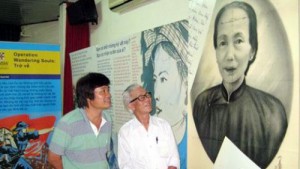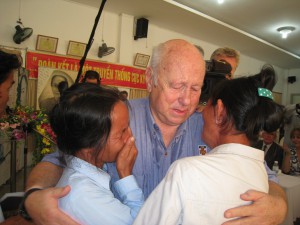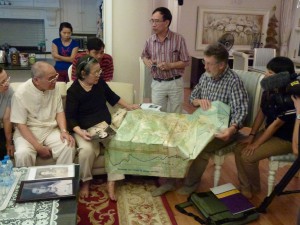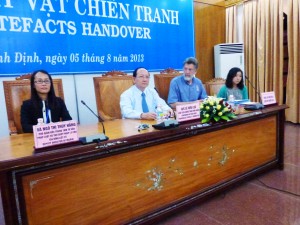Bob Hall, Andrew Ross, Derrill de Heer and Amy Griffin
Background
In 2009 Vietnam assisted Australia to find and repatriate the remains of six Australians still listed as missing in action (MIA) from the Vietnam War. With the assistance of the Vietnamese government and people, six Australian families could, at last, put the remains of their loved ones to rest in their homeland.
Vietnam has its own massive MIA problem. The government of the Socialist Republic of Vietnam estimates that about 300,000 Vietnamese soldiers remain MIA since the end of the war. In Vietnamese culture, those who die and are buried in unknown graves are thought to be ‘wandering souls’ unable to find rest in the spirit world until the necessary rituals are performed at their burial site by their kin. The Operation Wandering Souls project aimed to reciprocate the help given to Australia by assisting Vietnam to locate those of its MIAs who died in battle against Australian and New Zealand forces. This would allow the souls of their MIAs to find rest.
Work completed to date
-

Le Hang and his son, admiring the portrait of his mother, Phan Thi Vu. The portrait was rescued from a burning building by an Australian adviser. Le Hang was overjoyed to receive the portrait after its lengthy ‘holiday’ in Australia.
Data concerning the location of every battle or firefight fought by the Australian or New Zealand soldiers of 1ATF that is known to have resulted in the death of a Vietnamese soldier (of the National Liberation Front or Democratic Republic of Vietnam (North Vietnam) forces) has been provided to Vietnam as a database and as points plotted on Google Earth. Australian policy was to bury enemy bodies at the scene of battle and in most cases this happened, thus this information provides the best available record of burial sites.
- A database recording the names, dates of death, location of burial and other information pertaining to the identities of 535 of those Vietnamese killed in combat by Australian and New Zealand forces, and identified by name in Australian official records, has been provided to Vietnam. This information has been provided in the form of a spreadsheet and as points plotted on Google Earth images.
- A database showing the names, dates of death and location of burial sites for approximately 120 members of 33rd People’s Army of Vietnam Regiment has been provided to the 33 PAVN Regiment Association and to other Vietnamese authorities.
- In 2012, 2013 and 2014, on behalf of Australian and New Zealand veterans, the Operation Wandering Souls research team returned to Vietnam approximately 200 items of a personal or sentimental nature that had been captured on the battlefield by Australian or New Zealand soldiers. The return of these items generated intense interest in Vietnam and received wide positive coverage by Vietnamese television, radio and print media. The 2012 return of items was also covered by the ABC TV ‘Foreign Correspondent’ program. See the ABC TV ‘Foreign Correspondent’ report.
- The return of items in 2013 was covered by Channel 9 ‘Sunday Night’ program and was watched by an audience of 1.9 million. Watch the ‘Sunday Night’ program feature.
Project aims
In accordance with the spirit of the Geneva Conventions (Geneva Convention 1, Articles 16 and 17) the project aims to provide to Vietnam:
- As much information as is available from Australian official records about the location of the burial sites of those Vietnamese who died in battle against Australian and New Zealand forces during what the Vietnamese call the ‘American War’, and the identities of those buried therein.
- Articles of intrinsic or sentimental value or of a personal nature that were captured in Vietnam and are now held in Australia or New Zealand.
Why return these items?
-

After returning their father’s commendation certificate, Derrill de Heer comforts the soldier’s two daughters. For years the family, originally from a province near Hanoi, had searched for their father’s remains. Thinking that he had died in Cambodia, they settled in Tay Ninh province near the Cambodian border. The return of his commendation certificate confirmed that he had been killed in Phuoc Tuy Province in a firefight with 1ATF.
The Vietnamese people helped us find, identify and repatriate our six MIAs. Now we can help them by returning to Vietnamese families items that belonged to their loved ones that were captured on the battlefield or removed from bodies.
- The Geneva Conventions (Convention 1, articles 16 and 17) say we should.
- It’s the right thing to do. If the situation was reversed we’d like them to have done this for our families.
- We Vietnam veterans are getting old. The reminders of our lives as young soldiers that we picked up on the battlefield won’t be of much interest to our children. They’ll probably be thrown out once we’re gone. Now’s the time to do something with them. One thing that can be done with them is to return them to Vietnam where they may be reconnected with the family of a missing soldier.
How you can help
If you’ve got items that you found on the battlefield and would like to return them to Vietnamese families through Operation Wandering Souls please contact us. We can return items on your behalf or, if you would prefer, we can give you advice on how to return them to Vietnam yourself.
If the item you collected on the battlefield carries the name or other identifying information about the Viet Cong or People’s Army (VC/PAVN) soldier who once carried it, and you can recall something about the contact or the circumstances by which you acquired the item, the project team may be able to use that information to identify the burial site or establish the identity of the VC/PAVN soldier. The team may also be able to return these items to family members, giving them a tangible connection with their lost relative.
What should you do?
Please rummage through your old steel trunk or wherever the items are, find them and send them to the Operation Wandering Souls team along with as much as you can recall about the circumstances by which you ‘captured’ them. Alternatively, you can scan them and send the scanned image by email to the research team. You can contact the Operation Wandering Souls research team on the email address below or through this website. If you would prefer, you can send the items to the team anonymously.
What sort of items should be returned?
The items to be returned include any documents or artefacts that are of a personal nature (such as letters, personal diaries, poetry, drawings, notebooks, photographs, etc.) that were found on the battlefield or removed from bodies. Other items might include hammocks, torches, or other items, particularly if they have a name on them or you know some details of the contact in which they were captured. These items might help to identify the burial site of the VC/PAVN soldier who carried them during the war.
What the Operation Wandering Souls team will do

Bob Hall uses a topographical map to show a Hanoi family where their brother died in battle in an ambush set by New Zealand infantrymen in the Nui Dinhs. A photograph of their brother, held by his sister, was captured after the ambush. In this case, the captured photograph and details of the contact in which it was captured, have allowed the family to attempt to recover their brother’s remains from the ambush site. A six-figure grid reference in the contact report records the best available information about the location of the contact.
We’ll receive any item you send and create a facsimile copy or photograph to be retained at the University of New South Wales (at the Australian Defence Force Academy). We can also provide you with a facsimile copy or photograph if you would like. After providing a scanned image of the item to our contacts in Vietnam (so that they can begin the process of identifying family members) we’ll take or send the items to Vietnam for presentation to the family or to the Vietnam People’s Army which has a Hanoi-based unit dedicated to the identification and location of those of its soldiers still listed as missing in action.
If we are able to locate Vietnamese family members, you might like to visit Vietnam with us (at your expense) and personally return the items to the family.
What this project is NOT about
This project is not about fighting the war again, or about ideologies, or about how the communists treated those in the south after 1975; it is about our dealings, as decent, compassionate people, with the Vietnamese and how we treat our fellow men and women.
This is a healing opportunity and those who are able to participate will become part of one of the closing chapters of this conflict.
We invite you to participate in the return of the items if you have them.
The Operation Wandering Souls research team
Our research team consists of:
- Dr Bob Hall – Team leader and Vietnam veteran (8RAR)
- Dr Andrew Ross – Database and analysis guru
- Dr Amy Griffin – Geographic Information Systems expert
- Mr Derrill de Heer – Field researcher and Vietnam veteran (8RAR, Psyops and 4RAR/NZ)
- Mr Barry Smith – Field researcher and Vietnam veteran (1 Australian Civil Affairs Unit).
We are all contactable through this website.
To contact the team

Artefacts handover ceremony at Quy Nhon, Binh Dinh province. About 90 letters had been collected from Binh Dinh province by an Australian adviser. We were able to return many to family members. From the left, Ms Ngo Thi Thuy Hang, CEO of the MARIN centre, an NGO specialising in helping Vietnamese families find their MIA soldiers; Le Huu Loc, Province Chief, Binh Dinh Province; Bob Hall and Huyen Siccama, Bob’s interpreter. The handover ceremony attracted a lot of Vietnamese media coverage.
Contact Bob Hall or Derrill de Heer
Email: b.hall@adfa.edu.au or d.deheer@adfa.edu.au
Phone: +61 2 6268 8848
Mobile: 0439 887 580 or 0414 574 605
Snail mail
Bob Hall or Derrill de Heer
Operation Wandering Souls project
HASS
UNSW Canberra
PO Box 7916
Canberra BC
ACT 2610
Australia
